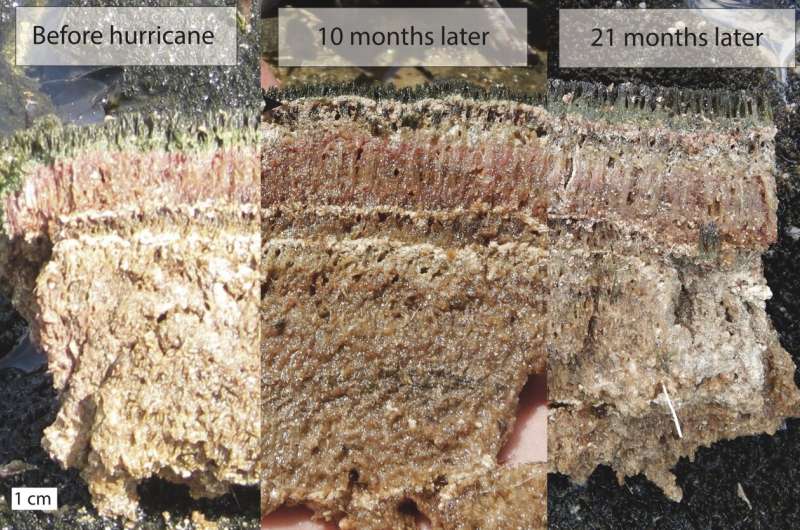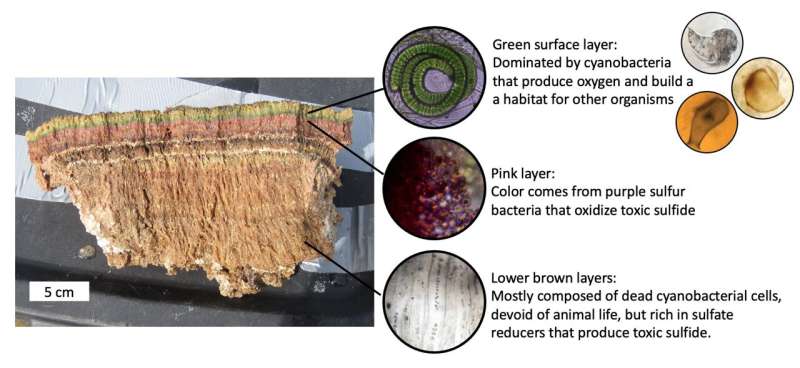In wake of hurricane, microbial ecosystem remarkably resilient

After sustaining seemingly catastrophic hurricane damage, a primordial groundcover vital to sustaining a multitude of coastal lifeforms bounced back to life in a matter of months.
The finding, co-led by a Johns Hopkins University geochemist and published today in Science Advances, offers rare optimism for the fate of one of Earth's most critical ecosystems as climate change alters the global pattern of intense storms.
"The good news is that in these types of environments, there are these mechanisms that can play an important role in stabilizing the ecosystem because they recover so quickly," said Maya Gomes, a Johns Hopkins assistant professor of Earth & Planetary Sciences. "What we saw is that they just started growing again and that means that as we continue to have more hurricanes because of climate change these ecosystems will be relatively resilient."
The team, co-led by California Institute of Technology and University of Colorado, Boulder, researchers, had been studying Little Ambergris Cay, an uninhabited island in Turks and Caicos, in particular the island's microbial mats. Microbial mats are a squishy, spongey ecosystems that for eons have sustained a diverse array of life from the microscopic organisms that that make a home in the upper oxygenated layers to the mangroves it helps root and stabilize, which in turn provide habitats for even more species. Mats can be found all over the world in wildly different environments, but the variety this team studied are commonly found in tropical, saltwater-oriented places, exactly the coastal locations most vulnerable to severe storms.
In September 2017, the eyewall of Category 5 Hurricane Irma directly hit the island the team had been working on.

"Once we learned everyone was OK, we were uniquely well-poised to investigate how the mat communities responded to such a catastrophic disturbance," Gomes said.
The tropical cyclone's impact was immediately devastating, choking the mats with a blanket of sandy sediment that decimated new growth. However, as the team checked on the site first in March 2018, then again in July 2018 and June 2019, they were excited to see the mats regrowing, with new mats visibly sprouting from the sand layer in as little as 10 months.
New mat growth proceeded rapidly and suggested that storm perturbation may facilitate these ecosystems adapting to changing sea levels.
"For islands and tropical locations with this type of geochemistry, Florida Keys would be one in the United States, this is sort of good news in that we think that the mangrove ecosystem as well as the microbial maps are pretty well stabilized and resilient," said lead author Usha F. Lingappa, a postdoctoral scholar at the University of California Berkeley.
The team also included: Co-senior author Woodward W. Fischer, Nathaniel T. Stein, Kyle S. Metcalfe, Theodore M. Present, Victoria J. Orphan and John P. Grotzinger, all of California Institute of Technology's Division of Geological and Planetary Sciences; Andrew H. Knoll of Harvard University; and co-senior author Elizabeth J. Trower of the University of Colorado Boulder.
More information: Usha F. Lingappa, Early impacts of climate change on a coastal marine microbial mat ecosystem, Science Advances (2022). DOI: 10.1126/sciadv.abm7826. www.science.org/doi/10.1126/sciadv.abm7826
Journal information: Science Advances
Provided by Johns Hopkins University




















